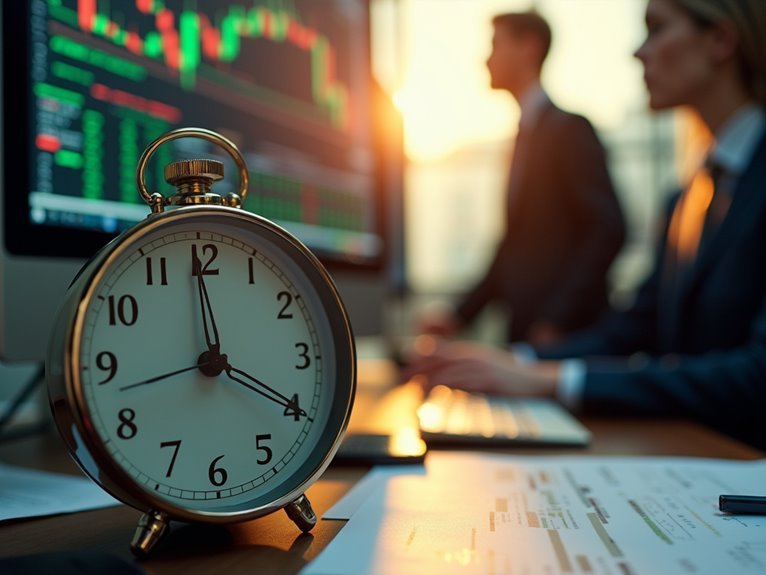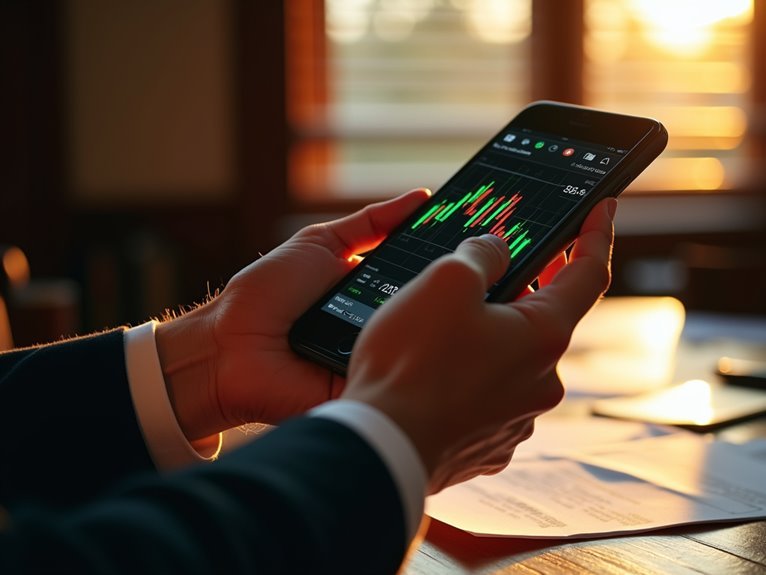Power hour in stock trading occurs during two key windows: 9:30-10:30 AM and 3:00-4:00 PM EST. Trading volume spikes 30-40% above midday averages as institutional investors flood markets with portfolio adjustments. The morning session reacts to overnight news, while afternoon focuses on position repositioning before market close.
This surge creates increased volatility and rapid price movements. Automated trading programs amplify the chaos, leading to sharp swings that present both lucrative opportunities and significant risks for traders who understand the dynamics.
Definition and Timing of Power Hour Trading

The power hour represents one of the most intense periods in stock trading, marked by surging volume and wild price swings that can make or break a trader’s day.
This phenomenon occurs during two critical windows. First, the opening hour from 9:30 AM to 10:30 AM EST. Second, the closing hour from 3:00 PM to 4:00 PM EST. Most traders specifically call the afternoon window “Power Hour.”
The closing session gets the most attention. It’s the final sixty minutes of regular trading. Institutional players reposition portfolios. Options expire. Traders scramble to close positions or set up swing trades for tomorrow.
Trading volume spikes 30-40% above midday averages. Volatility explodes. Friday afternoons hit hardest due to weekend risk.
The opening hour sets the day’s tone. Overnight news drives action. Earnings announcements fuel chaos. Global markets follow similar power hour patterns beyond just U.S. stock exchanges. Global markets influence momentum.
Power hour isn’t guaranteed daily. Market sentiment varies. News flow matters. Volume spikes indicate when legitimate moves are occurring during these intense trading windows. Real-time data confirms when it’s happening. The second-best trading time occurs during this period due to increased market volatility.
Key Characteristics and Market Drivers
Volume surges define power hour‘s most striking characteristic, with trading activity jumping 30-40% above midday levels as institutional money floods the market. Hedge funds and major investors issue large orders during these windows. The result? Sharp volatility swings.
Market sentiment shifts rapidly. Morning power hour reacts to overnight news and pre-market signals. The afternoon session sees position adjustments before close. Traders cut losses, lock in profits, or prepare for tomorrow’s open. Positive earnings reports from companies can trigger significant price spikes during morning trading sessions.
Morning sessions digest overnight developments while afternoon brings strategic positioning as traders rapidly adjust holdings before market close.
Liquidity spikes create faster executions and tighter spreads. This helps confirm breakouts and reversals, giving active traders actionable signals. But don’t be fooled—that same liquidity can vanish instantly if sentiment turns.
Automated trading programs amplify the chaos. Speculators pile in. The combination drives price movements that reflect true market valuation, factoring in dividends and splits. Real-time assessment becomes critical as opportunities flash and disappear within minutes. Friday afternoon sessions intensify further with expiring options driving additional volatility. New traders should begin with smaller positions to effectively manage the heightened risks during these volatile periods. Implementing proper position sizing techniques is essential for preserving capital while still capitalizing on the unique growth opportunities these high-activity windows present.
Trading Strategies During High-Volume Periods
Success in power hour trading hinges on recognizing that traditional strategies require significant adjustment. The heightened volatility demands faster execution and tighter risk controls.
Momentum trading thrives during these periods. Morning power hour momentum typically stems from overnight news or earnings reports. Afternoon sessions see traders adjusting positions before market close. Volume spikes exceeding 30-40% above midday averages signal institutional involvement and potential price moves. Experienced traders utilizing power hour strategies often achieve 5-15% monthly returns when applying disciplined risk management techniques.
Scalpers capitalize on rapid price swings for quick profits. They need low-latency platforms and real-time data feeds. Tight stop losses are essential. Large-cap stocks offer better liquidity and tighter spreads.
Technical indicators require volume context. Moving averages like 9 and 21 EMA help identify short-term trends. Breakout patterns on high volume confirm entry signals. RSI and Stochastic indicators flag overbought conditions amplified by volume surges.
Position adjustments occur frequently during afternoon power hour as traders close losing trades and lock in profits before overnight risks. Understanding overnight trading essentials helps traders make informed decisions about holding positions past market close, particularly when responding to global events that might impact opening prices.
Opportunities and Risk

While power hour presents lucrative trading opportunities, it demands careful navigation of amplified risks. News releases and earnings reports trigger sudden price spikes. Momentum traders exploit these moves using technical indicators like moving averages and RSI. High liquidity enables short-term traders to capitalize on quick price shifts for intraday gains. Developing a structured trading plan before entering power hour sessions can significantly improve decision-making under pressure. Similar to the ICT methodology, understanding institutional order flow can provide valuable insights into potential price movements during these high-volume periods.
| Opportunities | Risks | Mitigation Strategies |
|---|---|---|
| Breakout trades from heightened activity | Sharp adverse price moves | Stop-loss orders and strict position sizing |
| Quick price shifts for intraday gains | Price slippage from large volume trades | Monitor news catalysts around market times |
| Trend reversals amid volatile conditions | False breakouts and reversals | Disciplined risk management strategies |
However, elevated volatility increases risk of rapid losses. Price slippage becomes likely due to simultaneous large trades. Emotional trading risks rise as traders rush decisions. Spreads widen temporarily, increasing transaction costs. False breakouts demand increased vigilance and disciplined strategies.
Frequently Asked Questions
Does Power Hour Occur in International Markets Outside the US?
Power hour absolutely occurs in international markets. European exchanges like London show heightened activity from 8-9 AM and 3:30-4:30 PM GMT. Asian markets in Tokyo and Hong Kong experience similar volatility spikes during their local opening and closing hours. The phenomenon isn’t uniquely American. Institutional trading, news releases, and market sentiment drive these patterns globally. Each market’s power hour aligns with local trading sessions and time zones.
How Does Power Hour Differ on Market Holidays or Shortened Trading Days?
Power hour timing shifts on shortened trading days but still occurs with compressed windows. Trading volume drops due to reduced session length, yet volatility remains elevated as traders rush final positions. Market holidays eliminate power hour entirely since exchanges close. Participants adjust strategies for quicker execution within tighter timeframes. Institutional activity continues but retail urgency intensifies. Risk management becomes essential given accelerated price movements in condensed trading periods.
Can Retail Traders Compete Effectively Against Institutions During Power Hour?
Retail traders struggle against institutions during power hour. Sophisticated algorithms, superior capital, and faster execution give institutions clear advantages. Retail traders face wider spreads, increased slippage, and limited access to professional-grade data. While some profit opportunities exist due to high liquidity, success rates remain consistently lower. Technical analysis and strict risk management help, but speed and information gaps create significant barriers. The playing field isn’t level.
What Specific Platforms or Tools Work Best for Power Hour Trading?
TD Ameritrade’s thinkorswim dominates power hour trading with extensive real-time data and advanced charting. Interactive Brokers offers low latency execution vital for volatile periods. E*TRADE Pro provides strong intraday tools. Essential features include Level 2 market data, volume spike scanners, and hotkeys for rapid order entry. Mobile apps keep traders connected. Premium data vendors deliver tick-by-tick analytics. News aggregators flag market-moving catalysts during final trading sessions.
Do Cryptocurrencies or Forex Markets Have Similar Power Hour Patterns?
Cryptocurrencies and forex markets don’t have traditional power hours like stocks. Crypto trades 24/7 globally, creating irregular volatility spikes around regional market openings at UTC 00:00, 08:00, and 16:00. Forex shows heightened activity during session overlaps, particularly the London-New York window from 8 AM to 12 PM EST. Both markets exhibit event-driven rather than time-driven volume surges, making their “power hours” less predictable than stocks.
Conclusion
Power hour represents both opportunity and peril for traders. The final trading hour delivers heightened volatility and substantial volume. Smart traders capitalize on momentum shifts. Others get burned by false breakouts. Success requires disciplined strategy and tight risk management. The hour rewards preparation while punishing impulse decisions. Institutional activity drives most moves. Retail traders must respect this reality. Power hour isn’t guaranteed profits—it’s concentrated market dynamics demanding focused execution.



